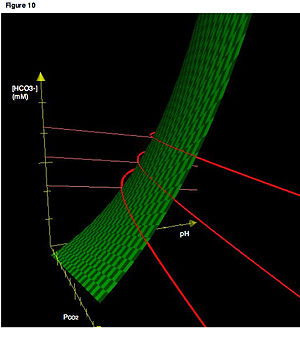
Blood gas analyzer

An arterial-blood gas (ABG) test measures the amounts of arterial gases, such as oxygen and carbon dioxide. An ABG test requires that a small volume of blood be drawn from the radial artery with a syringe and a thin needle, but sometimes the femoral artery in the groin or another site is used. The blood can also be drawn from an arterial catheter.There are two calculations for base excess (extra cellular fluid - BE(ecf); blood - BE(b)). The calculation used for the BE(ecf) = cHCO3– − 24.8 + 16.2 × (pH − 7.4). The calculation used for BE(b) = (1 − 0.014 × hgb) × (cHCO3– − 24.8 + (1.43 × hgb + 7.7) × (pH − 7.4).Body water: Intracellular fluid/Cytosol An arterial-blood gas (ABG) test measures the amounts of arterial gases, such as oxygen and carbon dioxide. An ABG test requires that a small volume of blood be drawn from the radial artery with a syringe and a thin needle, but sometimes the femoral artery in the groin or another site is used. The blood can also be drawn from an arterial catheter. An ABG test measures the blood gas tension values of the arterial partial pressure of oxygen, and the arterial partial pressure of carbon dioxide, and the blood's pH. In addition, the arterial oxygen saturation can be determined. Such information is vital when caring for patients with critical illnesses or respiratory disease. Therefore, the ABG test is one of the most common tests performed on patients in intensive-care units. In other levels of care, pulse oximetry plus transcutaneous carbon-dioxide measurement is a less invasive, alternative method of obtaining similar information. An ABG test can also measure the level of bicarbonate in the blood. Many blood-gas analyzers will also report concentrations of lactate, hemoglobin, several electrolytes, oxyhemoglobin, carboxyhemoglobin, and methemoglobin. ABG testing is mainly used in pulmonology and critical-care medicine to determine gas exchange across the alveolar-capillary membrane. ABG testing also has a variety of applications in other areas of medicine. Combinations of disorders can be complex and difficult to interpret, so calculators, nomograms, and rules of thumb are commonly used. ABG samples originally were sent from the clinic to the medical laboratory for analysis. Newer equipment lets the analysis be done also as point-of-care testing, depending on the equipment available in each clinic. Arterial blood for blood-gas analysis is usually drawn by a respiratory therapist and sometimes a phlebotomist, a nurse, a paramedic or a doctor. Blood is most commonly drawn from the radial artery because it is easily accessible, can be compressed to control bleeding, and has less risk for vascular occlusion. The selection of which radial artery to draw from is based on the outcome of an Allen's test. The brachial artery (or less often, the femoral artery) is also used, especially during emergency situations or with children. Blood can also be taken from an arterial catheter already placed in one of these arteries. There are plastic and glass syringes used for blood gas samples. Most syringes come pre-packaged and contain a small amount of heparin, to prevent coagulation. Other syringes may need to be heparinised, by drawing up a small amount of liquid heparin and squirting it out again to remove air bubbles. Once the sample is obtained, care is taken to eliminate visible gas bubbles, as these bubbles can dissolve into the sample and cause inaccurate results. The sealed syringe is taken to a blood gas analyzer. If a plastic blood gas syringe is used, the sample should be transported and kept at room temperature and analyzed within 30 min. If prolonged time delays are expected (i.e., greater than 30 min) prior to analysis, the sample should be drawn in a glass syringe and immediately placed on ice. Standard blood tests can also be performed on arterial blood, such as measuring glucose, lactate, hemoglobins, dys-haemoglobins, bilirubin and electrolytes. Derived parameters include bicarbonate concentration, SaO2, and base excess. Bicarbonate concentration is calculated from the measured pH and PCO2 using the Henderson-Hasselbalch equation. SaO2 is derived from the measured PO2 and calculated based on the assumption that all measured hemoglobin is normal (oxy- or deoxy-) hemoglobin. The machine used for analysis aspirates this blood from the syringe and measures the pH and the partial pressures of oxygen and carbon dioxide. The bicarbonate concentration is also calculated. These results are usually available for interpretation within five minutes.
